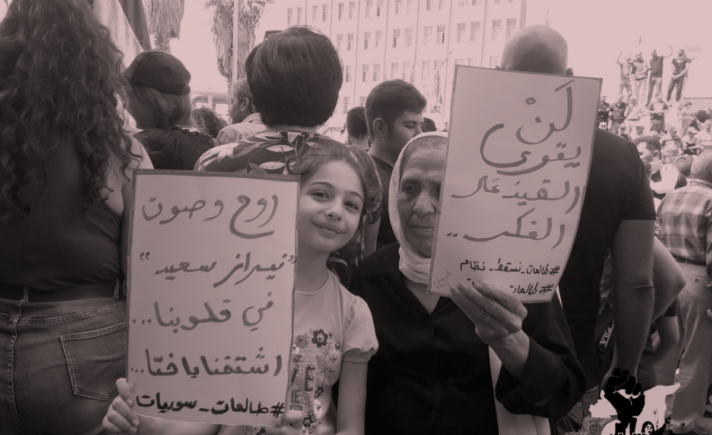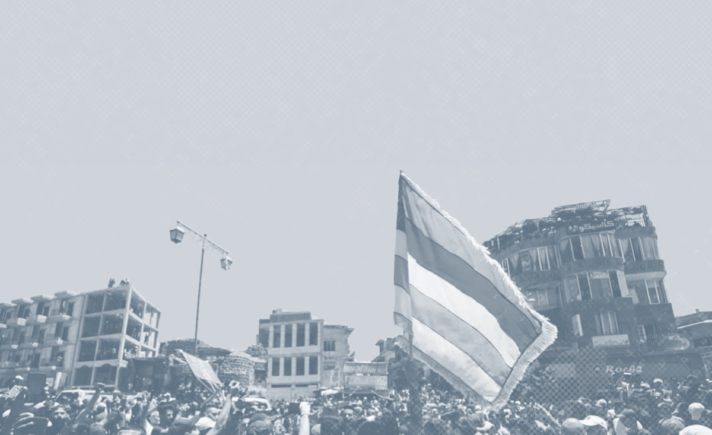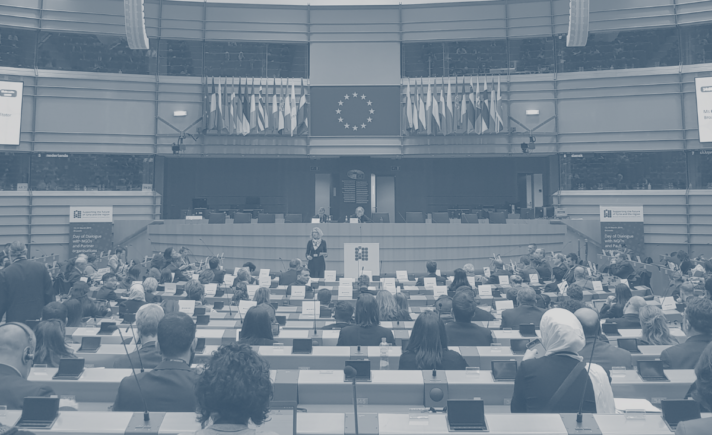Reiterating slogans from 2011 while incorporating additional chants, the uprising in As-Suwayda governorate has now reached its fourth week, rekindling a sense of cautious optimism among many Syrians. With a sense of comedy, protesters mockingly echo Bashar al-Assad’s recent statements in his interview with Sky News, in which he alleged that participators in internal protests never exceeded “a few more than 100,000,” chanting: “We are the ‘few’, we are the ‘few’, leave us be, we want to live!” This sentiment carries undeniable validity since As-Suwayda Governorate, with a population of approximately half a million according to the latest official statistics, does indeed represent “a few” within the broader Syrian context.
Over the past twelve years, As-Suwayda has borne witness to three distinct phases of opposition protest activities. It began with those who took part in the 2011 movement, characterized by its own rhetoric, symbols, and methods. Subsequently, some protesters took up arms to defend the particularity of the mountainous region and support those who sought to avoid compulsory military service in the regime’s army, such as the “Men of Dignity” movement. Out of this emerged a peaceful movement primarily focused on economic demands, epitomized by the 2015 “You Strangled Us” movement and the 2020 “We Want to Live” movement.
What distinguishes As-Suwayda’s movement today, despite being triggered by the government’s recent economic decisions which exacerbated the hardships faced by Syrians, is the convergence of aspirations for political change. Moreover, this movement features an array of new and diverse groups, including prominent figures like Sheikh Hikmat al-Hijri and Sheikh Hammoud al-Hanawi, both of whom are among the foremost spiritual leaders within the Druze community, which make up the majority of the governorate’s residents.
What “demands”, what rights?
“One of the most common pitfalls is the use of the word ‘demands’, which is often misconstrued by both the regime’s media and occasionally the opposition’s media.”
Thus began Mr. Ayman Shaib al-Din, a lawyer and human rights activist, in response to my question about the current chants and objectives of As-Suwayda’s residents. Within the Syrian context, the term ‘demands’ has been largely stripped of its political connotations and associated primarily with livelihood. The regime, by virtue of its own claim to legitimacy, considers itself the authority responsible for fulfilling these demands. However, the current aspirations of the people of As-Suwayda directly link their livelihoods to the need for political change.
Shaib al-Din, along with fellow lawyers, has been actively involved in peaceful protests in As-Suwayda since 2011. In response to the escalating arrest campaigns in As-Suwayda, he and his associates established an organization committed to defending detainees pro bono, offering legal support, and representing them in various courts. Shaib al-Din asserts that the slogans echoed by today’s protesters primarily revolve around rights rather than demands.
“Those partaking in the uprising are well aware that their so-called demands cannot be realized in the absence of a modern, legally and politically defined state in Syria, given that the so-called state in Syria is essentially an authoritarian regime,” adds Shaib al-Din. As a final point, he says, “We do not seek freedom, dignity, or decent living from the regime, nor do we anticipate that it will ever deliver on these fronts, as we are certain it was the one to strip us of them to begin with.”
Suhair, a 40-year-old civil activist, joined the ranks of anti-regime protesters in 2014 by participating in a sit-in protest at al-Fursan Square in As-Suwayda. Speaking with Aljumhuriya.net, she emphasized that the only viable path to attain the rights demanded by protesters lies in the international community’s response and the enforcement of Resolution 2254. Suhair acknowledges the formidable challenges to achieving this goal, but emphasizes that the protesters have no alternative but to persist on the streets until it is realized.
In this context, Karam Munther, an activist and volunteer in the organizing committee of the As-Suwayda movement, believes that today’s chants aim to “mobilize Syrians from all walks of life to join the peaceful uprising.” He stresses the need to temporarily set aside differences and disagreements for future discussions, once the regime is toppled. He echoes Shaib al-Din’s sentiment that these are not demands directed at the regime but rather “a reminder to the international community that ousting the regime is essential to securing the rights of Syrians, and that a political solution in Syria that includes Assad is untenable.”
Lawyer and human rights activist Shorouk Mamdouh contends that “the movement has reached an advanced stage, and the best that can be achieved in the short term is to secure some tangible gains.” She underscores the awareness among protesters of the daunting challenges involved in toppling the regime and implementing Resolution 2254. “It will require a considerable amount of time, international agreements, willpower, and the continued determination of the people,” she explains, “and anyone who thinks that the results will be instantaneous is completely mistaken.”
No to external funding, no to separatism
Persistent attempts to provide material and logistical support from abroad to sustain the As-Suwayda movement have consistently been met with unequivocal rejection, whether the attempts are from expatriate sons and daughters of the governorate or from other Syrians who support any revolutionary movement against the Assad regime within Syria. This resolute stance could be attributed to Syrians’ past experiences, prompting today’s protesters to preemptively address any anticipated accusations of foreign labor or mercenary involvement.
“The objective is for the movement to emerge spontaneously, driven by personal motivation, and rooted in a genuine desire for comprehensive change,” Shorouk Mamdouh asserts. It appears that the resilience demanded by Bashar al-Assad from Syrians over the past 12 years, which had become routine in response to economic and security pressures, has now turned against him. Suhair notes that Syrians have become accustomed to economic hardships, adept at managing with very little, and willing to cooperate amongst themselves to survive. This resilience contributes to the movement’s ability to endure on the streets.
“Today, As-Suwayda has reached an irreversible juncture,” she explains. “Over the course of twelve years, its residents have experienced the harsh realities imposed by this regime and the economic hardships endured by Syrians.” As a result, people are willing to walk from the outskirts of the governorate to al-Karamah Square, located in the heart of the city.
Hence, there is no concern that a scarcity of resources will impede the movement’s continuation. Shaib al-Din emphatically states that the demand for freedom and dignity does not require external support.
“Friends and family here assist one another,” he adds, “and the movement will not cease due to a lack of transportation means.” While this sentiment may sound idealistic, internal solidarity regarding resources is observable: several speakers from the city have mentioned their efforts to offer financial support for bus drivers or provide fuel for cars that transport protesters to the city square, especially on Fridays when protesters from various regions and villages converge in al-Karamah Square – ‘Square of Dignity,’ as it is now called. Yet those with transportation means have, so far, declined such offers, affirming that they will not hesitate to ask for support from fellow activists within the movement when the need arises. One protester even provided a mobile water tank placed in the square.
In this regard, Karam Munther emphasizes that financial support is rejected unless it is organized and transparent. Accepting vague or ambiguous support could potentially create divisions within the movement, a risk that simply cannot be taken. Shaib al-Din agrees. “We aim to dismantle the regime’s claims of receiving external funding,” he adds, “a tactic it employs to discredit anyone who opposes it.”
Regarding the possibility of accepting a settlement, all participants in discussions with Aljumhuriya.net stress that the regime has nothing substantial to offer except its departure and acceptance of a political solution. According to Suhair, “there is no alternative to demanding the ousting of the Syrian regime.” Human rights activist Mamdouh believes that the ceiling of demands is open and is not specific or restrictive, but the prospect of bargaining over these demands is unlikely given the course of events. Separatism is rejected, and there is no widespread inclination to accept self-administration in As-Suwayda.
“The primary slogan in the movement is ‘Syria’ – one unified entity,” Mamdouh clarifies. “We do not endorse fragmentation or separatism.” Mamdouh adds that some politicians and civilians in the governorate are working to develop a vision for the demands and their realization, with decentralization being advocated as part of a political solution. “It is essential to understand that decentralization is fundamentally different from autonomy or secession,” she adds. “On the contrary, it entails connecting to the state with specializations for local characteristics.”
Shaib al-Din notes that the notion of secession “is being propagated by the regime’s intelligence services,” considering that “the protesters in the squares, and their slogans, suffice to debunk this false narrative.” The conversation about a border crossing with Jordan is a long-standing demand linked to the economic stranglehold on As-Suwayda, a governorate solely reliant on agriculture and state employment. Mamdouh contends that “it is natural for there to be border crossings between countries for trade, transit, and resource exchange, which does not imply or confirm a request for separation in any way.” Meanwhile, Shaib al-Din asserts that those currently promoting the crossing as a means of separation are “cronies of the regime, such as Sheikh Youssef Jarbou’ and the governor’s representative, Nayef al-Aqel.” Al-Din emphasizes that this perspective is rejected by the movement and the entire population of As-Suwayda, who assert consistently that “their focus is on Syria and the Syrian people alone, and that As-Suwayda’s salvation is synonymous with the liberation of all Syrians from the tyranny, corruption, and criminality of the regime.”
Shaib al-Din acknowledges the existence of small groups within the movement that harbor “delusional” ideas about self-administration and autonomy for As-Suwayda. However, he reiterates that “As-Suwayda’s compass and history are rooted in national identity and will remain politically and ideologically national, rather than just poetically so.” Karam Munther also emphasizes this, saying, “We are a religious minority, but we constitute a national majority that rejects any division of Syrian land. We will oppose any settlement that does not meet the demands of all segments of the Syrian people.”
Women at the heart of protest
In compiling this article, I dedicated a separate section to discuss the involvement of women. I reached out to several women activists to inquire about their participation, and I received nearly identical responses from them: they share the view that there is no need for distinct categorization based on gender. Suhair emphasized that women’s presence on the streets “is not separate from the presence of men, and is not organized along factional lines.” Any chants or actions that might appear to be organized by women are simply “spontaneous expressions of solidarity and unity,” she explains: “One of the women simply initiates a chant or action, and the rest of us follow and gather around her, chanting in unison. If a woman comes up with an idea, such as wearing the traditional dress of the governorate, we readily support and embrace it without the need for analysis, coordination, discussion, or argument.” Shorouk Mamdouh echoes this sentiment, stating: “Women are active partners, revolutionaries, participants, and supporters in all aspects of change, peace-building, and struggle.”
In As-Suwayda, women, much like men, have been actively participating in public spaces since the inception of the movement. This participation is facilitated by the relatively open environment and the economic structure of the governorate. As the local economy relies primarily on state employment and agriculture, and the former often requires educational qualifications from institutes and universities, the percentage of educated women in state employment is nearly equivalent to that of men. Women are already deeply involved in agricultural activities as well.
The regime merely looks on – for now
Up to this point, the Syrian regime’s response has been somewhat ambiguous, as if it is in the process of reshuffling its cards. There have been warnings issued by individuals affiliated with and loyal to the regime regarding the potential infiltration of suicide bombers into As-Suwayda. Concurrently, the regime withdrew its personnel from the checkpoints surrounding the governorate. These concerns were addressed after protesters responded by establishing temporary barriers to monitor incoming vehicles, and emphatically conveyed that the regime would be held responsible for any such incidents.
Moreover, some members of the People’s Assembly and certain officials who appeared on both regime-affiliated media channels (as well as al-Arabiya) expressed favorable sentiments toward As-Suwayda. They seemingly disregarded the slogans calling for the overthrow of the regime and the departure of Assad, and emphasized the legitimacy of the people’s demands. This approach might be an attempt to exacerbate divisions with other opposition groups critical of the As-Suwayda movement, who effectively categorize it as primarily a “hunger movement.”
According to insider sources, intelligence service members from the governorate conveyed implicit threats or warnings to individuals associated with the movement. These messages included demands for substantial sums of money to remove the name of an activist from the list of individuals sought by State Security, with the condition that the activist stop participating in the movement. Such requests were largely ignored, as many recipients believed they had reached a point of no return, with the escalation expected to continue in the coming days.
In response to these developments, Shaib al-Din stated, “Our only readiness is to remain on the streets. We have no choice but to stand firm and continue to voice our demands. The broader movement does not anticipate anything from the regime other than disregard, to begin with. The regime cannot even provide consistent electricity for three hours, so expecting political freedoms and rights from it is out of the question. We are severing ties with the regime. We demand its departure so that we can construct a new Syria without Assad.”
It is worth noting the evolving stance of many former loyalists who are becoming more and more involved in today’s movement, excluding active Baathists who maintain direct links to the regime. These Baathists are reportedly in a state of shock. According to Shaib al-Din, there are no instances of tashbih (regime loyalists who often physically assault or threaten demonstrators) in the city center or in the villages throughout the entire governorate.
Today’s movement cannot be viewed in isolation from the 2011 uprising, as it inherits the spirit of breaking the silence, shattering the barrier of fear, and having to experience the regime’s brutality — all of which continue to impact Syrians both inside Syria and in the diaspora. However, the present context has shifted, compelling new groups to join the movement, advocating against the regime and demanding its departure.
The ongoing civil movement in As-Suwayda is expanding and gaining momentum day by day. “We are committed to staying on the streets and have no intention of retreating in the foreseeable future,” says Shorouk. “The process of organizing our presence on the streets has begun with open and widespread invitations for gatherings on Fridays and Mondays. Even if the regime continues to ignore and neglect us, it will not deter the demonstrators from their resolve to continue.”





